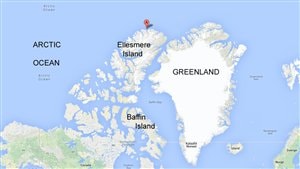It was a voice from the past, in one of the most remote areas on earth.

In 1959, a young geologist from Ohio in the USA, Paul T Walker, was on Ward Hunt Island in the high Arctic. It’s the closest Canadian land to the north pole, while the nearest tiny community Grise Fjord, is 800km away to the south. While there he set up a small cairn right at the edge of the glacier with a note inside.
“TO WHOM IT MAY CONCERN” (P.Walker; 1959)
The note in neat cursive writing on lined paper asked whoever found the note to measure the distance from the cairn to the edge of the glacier and forward the information back to his university and to a colleague Albert Crary of Boston. The note proved to be one of the last things he wrote.
He fell ill and had to be flown off the island and died later that year. He was only 27.

This year Warwick Vincent and his team from Laval University in Quebec City,were working at the Laval research station set up in 2010.
They discovered the small cairn and the note still inside a bottle inside the cairn.
In 1959, the glacier was only 1.2 metres from the glacier edge. This year the Laval University team measured and found it had retreated to 101.5 metres.
For me, it was an incredible thing to hold this in my hands, because these two people, these are very famous names,” said Vincent. A hill on Ward Hunt Island, Nunavut, is named after Walker.
The scientists remarked on the precience of the young researcher saying no-one would have funded deglaciation in the 1950s. They would surely have though the cairn would be overridden by the glacier advance, not its retreat.
Dr Vincent, who has been working in the high Arctic for 15 years is not surprised however at the glacial retreat.
“The changes are extraordinary, particularly the last 10 years, and especially the last two years”, he saic.
He also witnessed the break up of the Ward Hunt ice shelf, the biggest such shelf in the Arctic. It was as thick in places as a 33-storey building and probably more than 4,000 years old.
He says, “Suddenly our camera caught this open water, we think for the first time in thousands of years.”
Vincent at the team photographed the original message before placing it back in the bottle in the cairn.
They also added their own message asking the next person to find the message to measure the retreat and report back to Quebec City







For reasons beyond our control, and for an undetermined period of time, our comment section is now closed. However, our social networks remain open to your contributions.